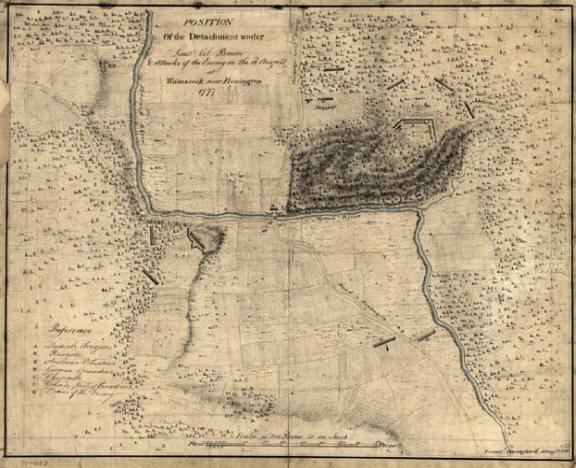Battle of Bennington
|
|
This Site:
|
Original Map of the Battle of Bennington Bennington, BATTLE NEAR. Falling short of provisions, Burgoyne sent out an expedition from his camp on the Hudson River to procure cattle, horses to mount Riedesel's dragoons, to "try the affections of the country," and to complete a corps of loyalists. Colonel Baum led the expedition, which consisted of 800 men, comprising German dragoons and British marksmen, a body of Canadians and Indians, some loyalists as guides, and two pieces of artillery. They penetrated the country eastward of the Hudson towards Bennington, Vermont, where the Americans had gathered a considerable quantity of supplies. At that time (August, 1777), General Stark, disgusted because he had not been made a Continental brigadier-general, had resigned his colonelcy, taken the leadership of the New Hampshire militia, with the stipulation that he was to have an independent command, and was at Bennington with part of a brigade. He had lately refused to obey a command of General Lincoln to join the main army opposing Burgoyne. It was a fortunate circumstance, for he did better service when Baum approached and began to cast up entrenchments (August 14, 1777) in the township of Hoosick, New York, within about 5 miles of Bennington. Informed of that approach, Stark had sent expresses for Warner's shattered regiment, and for militia, and he soon gathered many fugitives from the disaster at Hubbardton. The 15th was rainy. Baum had sent back to Burgoyne for reinforcements, and Stark was waiting for the arrival of more expected troops from Berkshire. Warner joined Stark on the morning of the 15th —he and his men drenched during a night march in the rain. The 16th dawned bright and hot, and Stark proceeded to execute a plan of attack on Baum's intrenched position by dividing his force and making a simultaneous attack at different points. The frightened Indians with Baum dashed through the encircling lines of the Americans, and fled to the shelter of the woods. After a severe contest of two hours' duration, the ammunition of the Germans failed, and they attempted to break through the line of besiegers with bayonets and sabres. In that attempt Baum was slain and his veterans were made prisoners. At that moment Lieutenant-Colonel Breyman appeared with the jaded reinforcements which Burgoyne had sent, and Stark was joined by some fresh troops furnished by Warner. The cannon which had been taken from the Germans, were immediately turned upon Breyman's men. A fierce battle continued until sunset, when Breyman retreated, leaving all his artillery. and nearly all his wounded, behind. The Germans lost, in killed, wounded, and prisoners, nearly 1,000 men. The Americans lost less than 100. On August 19, 1891, a monument commemorating the victory was dedicated at Bennington. It is a shaft of magnesian limestone, 308 feet high; and near the city the national government has since established a military post. |
|
|
||
|
|
Site Copyright 2003-2018 Son of the South. For Questions or comments about this collection, contact: paul@sonofthesouth.net |
|
|
Are you Scared and Confused? Read My Snake Story, a story of hope and encouragement, to help you face your fears. |
||
